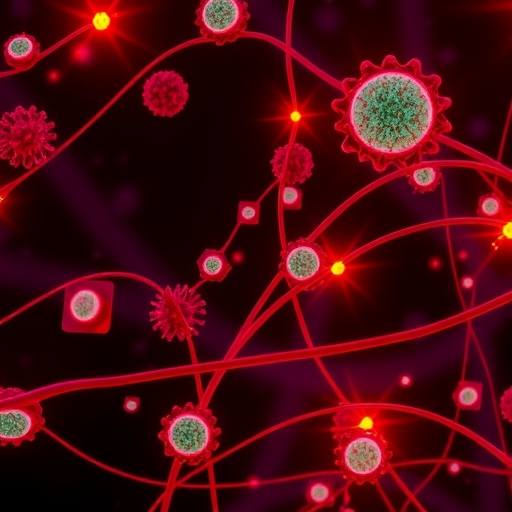
In a groundbreaking study set to redefine our understanding of immune metabolism in chronic inflammatory diseases, Kao et al. reveal the intricate metabolic reprogramming of a specific subset of immune cells known as interleukin-17-producing γδ T cells. The work uncovers how these cells, under psoriatic conditions, engage a sophisticated biochemical pathway that pivots on ACC1-mediated de novo lipogenesis—a process essential for their pathogenic function in psoriasis. These revelations, published in Nature Metabolism, open promising therapeutic avenues for a disease that affects millions worldwide but remains incompletely understood at the cellular metabolic level.
Psoriasis, a chronic autoimmune skin condition characterized by hyperproliferative keratinocytes and sustained inflammation, involves a complex interplay of immune cells, cytokines, and metabolic signaling. While the proinflammatory cytokine interleukin-17 (IL-17) has been established as a key driver of psoriasis pathology, the cellular and molecular mechanisms that control IL-17 production, especially by γδ T cells, have remained elusive. Kao and colleagues’ study is an ambitious deep dive into the metabolic landscape underpinning these cells’ pathogenic differentiation and survival.
At the heart of the study lies the identification of a metabolic shift within IL-17-producing γδ T cells that favors ACC1 (acetyl-CoA carboxylase 1)-mediated lipogenesis. ACC1 catalyzes the conversion of acetyl-CoA to malonyl-CoA, a critical step in de novo synthesis of fatty acids. This lipid biosynthesis pathway is not trivial; it provides membrane components and signaling molecules imperative for the proliferation and effector functions of immune cells, particularly under inflammatory stress. The researchers demonstrated that, during psoriasis-like conditions, γδ T cells undergo metabolic reprogramming that elevates ACC1 activity, thereby boosting lipogenesis to satisfy increased bioenergetic and biosynthetic demands.
Using a combination of in vitro experiments and innovative in vivo mouse models, the team meticulously charted metabolic fluxes in γδ T cells stimulated by psoriatic inflammation. They employed multi-omics approaches integrating transcriptomics, metabolomics, and lipidomics, which collectively underscored the enhanced lipogenic signature of activated IL-17-producing γδ T cells. Notably, genetic ablation or pharmacological inhibition of ACC1 led to a stark reduction in IL-17 secretion, underscoring the enzyme’s pivotal role in modulating T cell effector functions.
A particularly fascinating aspect of the findings is the demonstration that ACC1-mediated lipogenesis not only fuels energetic requirements but also shapes the epigenetic landscape of γδ T cells. The increased availability of lipid intermediates influences histone modifications that reinforce IL-17 gene expression, suggesting a multifaceted role of metabolism in immune regulation. This crosstalk between metabolic and epigenetic layers adds new complexity to how immune cells adapt in hostile environments such as psoriatic lesions.
The implications of these discoveries extend beyond psoriasis. They speak to a broader theme emerging in immunometabolism: immune cell function cannot be disentangled from tailored metabolic programs that sustain their differentiation, survival, and cytokine production. γδ T cells, often overshadowed by their αβ counterparts, emerge here as metabolically unique actors whose lipogenic reprogramming is indispensable for their proinflammatory role. Targeting metabolic enzymes like ACC1 offers a novel, potentially more specific approach to tempering immune-mediated pathology without broadly suppressing the immune system.
Indeed, the therapeutic potential shines bright. The study tested a small-molecule inhibitor of ACC1, demonstrating that dampening de novo lipogenesis ameliorated psoriasiform skin inflammation in preclinical models. This strategy avoids traditional immunosuppressants’ pitfalls, potentially allowing precise modulation of pathogenic T cells while sparing other immune functions. If translatable to humans, this could herald a new class of metabolism-centered interventions in psoriasis and perhaps other IL-17-driven inflammatory disorders.
Beyond therapeutic implications, this research enriches fundamental immunology by illustrating how metabolic pathways can dictate T cell fate decisions. The authors propose that environmental cues in the psoriatic milieu, including cytokines and nutrient availability, converge to remodel γδ T cell metabolism. This metabolic plasticity enables cells to meet the complex demands of chronic inflammation but also, inadvertently, perpetuates disease. Understanding these adaptive mechanisms at molecular resolution is crucial for developing interventions that can reset immune homeostasis.
The study’s robustness stems from sophisticated methodologies: high-dimensional flow cytometry, conditional gene knockout models, and flux analyses with isotope tracers, all crafted to dissect the biochemical minutiae of γδ T cell metabolism. This multidimensional approach illuminates dynamic changes in real time, painting a comprehensive metabolic portrait previously unattainable. Coupled with advanced imaging and epigenetic profiling, the integrated data weave a compelling narrative of immunometabolic orchestration.
Intriguingly, the metabolic rewiring observed in γδ T cells may also reflect a broader paradigm applicable to other inflammatory diseases where IL-17 and similar cytokines play a pathogenic role, such as multiple sclerosis, rheumatoid arthritis, and inflammatory bowel disease. This raises the exciting prospect of ACC1 or related metabolic nodes as universal targets across a spectrum of immune-mediated disorders, underlining the value of metabolic research in immunotherapy development.
While promising, the findings prompt further questions that future research must address. For example, how do metabolic fluxes integrate with other cellular processes like autophagy, mitochondrial dynamics, or reactive oxygen species generation in γδ T cells? What are the long-term consequences of inhibiting ACC1 on systemic lipid homeostasis? Can metabolic inhibitors be designed to target γδ T cells selectively, minimizing off-target effects?
Perhaps equally important is to explore whether metabolic interventions can synergize with existing biologics targeting IL-17 or its receptor, enhancing therapeutic efficacy or overcoming drug resistance. This multimodal approach may capitalize on the metabolic vulnerabilities elucidated by Kao et al., crafting personalized treatment regimens tailored to patients’ immunometabolic profiles.
In summary, this seminal work exposes a hitherto unappreciated layer of complexity in psoriasis pathogenesis. By dissecting the metabolic code that equips IL-17-producing γδ T cells to thrive and inflict tissue damage, the study paves the way for novel, metabolism-centric strategies to quell chronic skin inflammation. As metabolic reprogramming emerges as a critical determinant of immune cell identity and function, these insights reinforce the paradigm that bioenergetics is as crucial as genetic programming in disease manifestation.
Kao and colleagues’ revelations spotlight the transformative potential of immunometabolism in uncovering disease mechanisms and innovating therapeutic approaches. They remind us that the immune system’s most potent weapons—cytokines and cellular effectors—are inextricably linked to metabolic pathways that sustain and regulate their activity. Targeting these pathways with precision could revolutionize the management of psoriasis and usher in a new era of metabolic immunotherapy.
Subject of Research: Metabolic reprogramming of interleukin-17-producing γδ T cells in psoriasis.
Article Title: Metabolic reprogramming of interleukin-17-producing γδ T cells promotes ACC1-mediated de novo lipogenesis under psoriatic conditions.
Article References:
Kao, YS., Lauterbach, M., Lopez Krol, A. et al. Metabolic reprogramming of interleukin-17-producing γδ T cells promotes ACC1-mediated de novo lipogenesis under psoriatic conditions. Nat Metab (2025). https://doi.org/10.1038/s42255-025-01276-z
Image Credits: AI Generated
Tags: ACC1-mediated lipogenesis in inflammationcellular mechanisms in psoriasis pathologychronic autoimmune skin diseasescytokine signaling in psoriasisimmune metabolism in chronic inflammationinterleukin-17 and psoriasismetabolic pathways in autoimmune diseasesmetabolic reprogramming in immune cellspathogenic differentiation of γδ T cellsrole of IL-17 in skin conditionstherapeutic avenues for psoriasis treatmentγδ T cells in psoriasis





